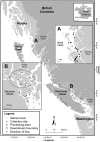Sea louse infection of juvenile sockeye salmon in relation to marine salmon farms on Canada's west coast
- PMID: 21347456
- PMCID: PMC3035676
- DOI: 10.1371/journal.pone.0016851
Sea louse infection of juvenile sockeye salmon in relation to marine salmon farms on Canada's west coast
Abstract
Background: Pathogens are growing threats to wildlife. The rapid growth of marine salmon farms over the past two decades has increased host abundance for pathogenic sea lice in coastal waters, and wild juvenile salmon swimming past farms are frequently infected with lice. Here we report the first investigation of the potential role of salmon farms in transmitting sea lice to juvenile sockeye salmon (Oncorhynchus nerka).
Methodology/principal findings: We used genetic analyses to determine the origin of sockeye from Canada's two most important salmon rivers, the Fraser and Skeena; Fraser sockeye migrate through a region with salmon farms, and Skeena sockeye do not. We compared lice levels between Fraser and Skeena juvenile sockeye, and within the salmon farm region we compared lice levels on wild fish either before or after migration past farms. We matched the latter data on wild juveniles with sea lice data concurrently gathered on farms. Fraser River sockeye migrating through a region with salmon farms hosted an order of magnitude more sea lice than Skeena River populations, where there are no farms. Lice abundances on juvenile sockeye in the salmon farm region were substantially higher downstream of farms than upstream of farms for the two common species of lice: Caligus clemensi and Lepeophtheirus salmonis, and changes in their proportions between two years matched changes on the fish farms. Mixed-effects models show that position relative to salmon farms best explained C. clemensi abundance on sockeye, while migration year combined with position relative to salmon farms and temperature was one of two top models to explain L. salmonis abundance.
Conclusions/significance: This is the first study to demonstrate a potential role of salmon farms in sea lice transmission to juvenile sockeye salmon during their critical early marine migration. Moreover, it demonstrates a major migration corridor past farms for sockeye that originated in the Fraser River, a complex of populations that are the subject of conservation concern.
Conflict of interest statement
Figures




Similar articles
-
Sea lice, Lepeophtheirus salmonis, transfer between wild sympatric adult and juvenile salmon on the north coast of British Columbia, Canada.J Fish Dis. 2009 Jan;32(1):45-57. doi: 10.1111/j.1365-2761.2008.01003.x. J Fish Dis. 2009. PMID: 19245630
-
Reduced growth in wild juvenile sockeye salmon Oncorhynchus nerka infected with sea lice.J Fish Biol. 2017 Jul;91(1):41-57. doi: 10.1111/jfb.13325. Epub 2017 May 29. J Fish Biol. 2017. PMID: 28556094
-
Oust the louse: leaping behaviour removes sea lice from wild juvenile sockeye salmon Oncorhynchus nerka.J Fish Biol. 2018 Aug;93(2):263-271. doi: 10.1111/jfb.13684. J Fish Biol. 2018. PMID: 29956312
-
Salmon lice--impact on wild salmonids and salmon aquaculture.J Fish Dis. 2013 Mar;36(3):171-94. doi: 10.1111/jfd.12061. Epub 2013 Jan 13. J Fish Dis. 2013. PMID: 23311858 Free PMC article. Review.
-
How sea lice from salmon farms may cause wild salmonid declines in Europe and North America and be a threat to fishes elsewhere.Proc Biol Sci. 2009 Oct 7;276(1672):3385-94. doi: 10.1098/rspb.2009.0771. Epub 2009 Jul 8. Proc Biol Sci. 2009. PMID: 19586950 Free PMC article. Review.
Cited by
-
Pathogens from salmon aquaculture in relation to conservation of wild Pacific salmon in Canada.Sci Adv. 2024 Oct 18;10(42):eadn7118. doi: 10.1126/sciadv.adn7118. Epub 2024 Oct 16. Sci Adv. 2024. PMID: 39413187 Free PMC article. Review.
-
The Salmon Louse Lepeophtheirus salmonis (Copepoda: Caligidae) life cycle has only two Chalimus stages.PLoS One. 2013 Sep 12;8(9):e73539. doi: 10.1371/journal.pone.0073539. eCollection 2013. PLoS One. 2013. PMID: 24069203 Free PMC article.
-
Sustainable aquaculture through the One Health lens.Nat Food. 2020 Aug;1(8):468-474. doi: 10.1038/s43016-020-0127-5. Epub 2020 Aug 3. Nat Food. 2020. PMID: 37128071 Review.
-
Wild salmon migration routes influence sea lice infestations: An agent-based model predicting farm-related infestations on juvenile salmon.PLoS One. 2024 Aug 20;19(8):e0309215. doi: 10.1371/journal.pone.0309215. eCollection 2024. PLoS One. 2024. PMID: 39163380 Free PMC article.
-
Effects of parasites from salmon farms on productivity of wild salmon.Proc Natl Acad Sci U S A. 2011 Aug 30;108(35):14700-4. doi: 10.1073/pnas.1101845108. Epub 2011 Aug 22. Proc Natl Acad Sci U S A. 2011. PMID: 21873246 Free PMC article.
References
-
- Thirgood S. New perspectives on managing wildlife diseases. J Appl Ecol. 2009;46:454–456.
-
- Power AG, Mitchell CE. Pathogen spillover in disease epidemics. Am Nat. 2004;164:S79–S89. - PubMed
Publication types
MeSH terms
LinkOut - more resources
Full Text Sources
Miscellaneous

